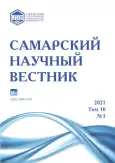Biostability of synthetic polymer materials – polyethylene, polypropylene and polycarbonate – in the conditions of Surgut
- Authors: Mantrova M.V.1
-
Affiliations:
- Surgut State University
- Issue: Vol 10, No 1 (2021)
- Pages: 107-112
- Section: General Biology
- URL: https://journals.rcsi.science/2309-4370/article/view/70312
- DOI: https://doi.org/10.17816/snv2021101116
- ID: 70312
Cite item
Full Text
Abstract
The paper is devoted to the study of biostability of polyethylene, polypropylene and polycarbonate in the conditions of Surgut after their presence within a year in different types of soils – swamp-podzolic soil, culturosem and urbanozem. The studied types of soils differ in their chemical composition – urbanozems are saturated with bases, have a slightly alkaline reaction, they also contain an excess of lead content due to their close location to highways. In the studied soils bacterial microflora prevails over mycoflora, the amount of heterotrophic and lithoautotrophic microflora in urbanozems is especially high, which is due to the high anthropogenic load on these soils. For seeds and seedlings of wheat and radish the stimulating effect of these soils was revealed. Micromycetes isolated from the surface of polypropylene and polyethylene pipes are typical soil saprotrophs that can act as biodestructors of polymers. In the field experiment all the materials under study are biostable, and there was a slight change in the color of the cross-linked polyethylene sample. In the laboratory experiment certain instability of all the materials under study was revealed; their gradation in terms of mushroom resistance (from resistant to unstable) is as follows: low-density polyethylene, polypropylene random-heat-resistant copolymer, polycarbonate, cross-linked polyethylene. The nature of damage to low-density polyethylene (polyethylene film) is superficial, which corresponds to the literature data.
Full Text
##article.viewOnOriginalSite##About the authors
Maria Viktorovna Mantrova
Surgut State University
Author for correspondence.
Email: mantrova-mariya@yandex.ru
junior researcher of Scientific and Educational Center of Institute of Natural and Technical Sciences
Russian Federation, Surgut, Khanty-Mansi Autonomous Okrug – YugraReferences
- Карамова Н.С., Надеева Г.В., Багаева Т.В. Методы исследования и оценки биоповреждений, вызываемых микроорганизмами: учеб.-метод. пособие. Казань: Казанский университет, 2014. 36 с.
- Сухаревич В.И., Кузикова И.Л., Медведева Н.Г. Защита от биоповреждений, вызываемых грибами. СПб.: ЭЛБИ-СПб, 2009. 207 с.
- Лугаускас А.Ю., Микульскене А.И., Шляужене Д.Ю. Каталог микромицетов – биодеструкторов полимерных материалов. М.: Наука, 1987. 340 с.
- Микробиологическое разрушение материалов: учеб. пособие для студентов, обучающихся по направлению 270100 «Строительство» / под общ. ред. В.Т. Ерофеева, В.Ф. Смирнова. М.: Изд-во Ассоц. строит. вузов, 2008. 123 с.
- Смирнов В.Ф., Веселов А.П., Семичева А.С., Смирнова О.Н., Захарова Е.А. Экологические и биологические аспекты деструкции промышленных материалов микроорганизмами. Н. Новгород: Изд-во ННГУ, 2002. 99 с.
- Каневская И.Г. Биологическое повреждение промышленных материалов. Л.: Наука, 1984. 232 с.
- Sedlbauer K. Vorhersage von Schimmelpilzbildung auf und in Bauteilen: dis. … Dr.-Ing. Stuttgart, 2001.
- Fuesting M.L., Bahn A.N. Synergistic bactericidal activity of ultasonics, ultraviolet light and hydrogen peroxide // Journal of Dental Research. 1980. Vol. 59. P. 391.
- Бухин В.Е. Полипропиленовые напорные трубопроводы в инженерных системах зданий. М.: Авок-Пресс, 2010. 108 с.
- Бахтияров Р.Ф. Сотовый поликарбонат – современное энергосберегающее покрытие для теплиц // Гавриш. 2011. № 3. С. 33–35.
- ГОСТ 9.048–89. Изделия технические. Методы лабораторных испытаний на стойкость к воздействию плесневых грибов: государственный стандарт Союза ССР. Введ. 1991–06–30. М., 1989. 22 с.
- Аринушкина Е.В. Руководство по химическому анализу почвы. М.: Изд-во МГУ, 1970. 487 с.
- Русак С.Н., Кравченко И.В., Филимонова М.В., Башкатова Ю.В. Экологическая биохимия растений: химические и биохимические методы анализа: метод. рекомендации. Сургут: Изд. центр СурГУ, 2012. 39 с.
- Руководство к практическим занятиям по микробиологии / под ред. Н.С. Егорова. М.: Изд-во МГУ, 1995. 224 с.
- Бакаева М.Д. Комплексы микромицетов нефтезагрязнённых и рекультивируемых почв: дис. … канд. биол. наук. Уфа, 2004. 172 с.
- Почва, город, экология / под общ. ред. акад. РАН Г.В. Добровольского. М.: Фонд «За экономическую грамотность», 1997. 320 с.
- Горбань М.В., Ямпольская Т.Д. Физиологические аспекты деструкции синтетических и природных полимеров коллекционными и аборигенными штаммами микромицетов // Известия Самарского научного центра РАН. 2012. Т. 14, № 1 (9). С. 2206–2210.
- Food and indoor fungi / R.A. Samson, J. Houbraken, U. Thrane, J.C. Frisvad, B. Andersen. Utrecht (The Netherlands): CBS-KNAW Fungal Biodiversity Centre, 2010. 390 p.
- Мирчинк Т.Г. Почвенная микология. М.: Изд-во МГУ, 1988. 220 с.
- Контроль химических и биологических параметров окружающей среды / под ред. Л.К. Исаева. СПб.: Эколого-аналитический информационный центр «Союз», 1998. 896 с.
Supplementary files








